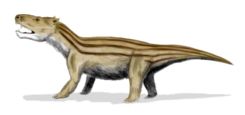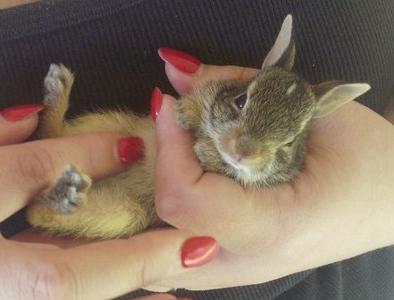 Even as a young skeptic Easter Sunday was exciting for me. As children, my sisters and I could always count on finding a basket full of yummy chocolate treats waiting for us on Easter morning. How exactly the most important date in the Christian calendar came to be associated with an anthropomorphic pagan rabbit hiding colored candy eggs is a story for another day. But real rabbits also have a story. One nearly as mysterious, every bit as interesting, and as fun for the whole family, as Peter Cottontail’s.
Even as a young skeptic Easter Sunday was exciting for me. As children, my sisters and I could always count on finding a basket full of yummy chocolate treats waiting for us on Easter morning. How exactly the most important date in the Christian calendar came to be associated with an anthropomorphic pagan rabbit hiding colored candy eggs is a story for another day. But real rabbits also have a story. One nearly as mysterious, every bit as interesting, and as fun for the whole family, as Peter Cottontail’s.
The first proto-mammals are often referred to collectively as cynodonts, some probably looked and acted an awful lot like modern hamsters, and they really did lay eggs!  Cynodonts appear in the fossil record during the Permian over 250 million years ago and slowly evolved into placental mammals that give birth to live young. They came in various shapes and sizes, but most and especially those that evolved into rabbits, and people, may have looked something like this guy, right.
Cynodonts appear in the fossil record during the Permian over 250 million years ago and slowly evolved into placental mammals that give birth to live young. They came in various shapes and sizes, but most and especially those that evolved into rabbits, and people, may have looked something like this guy, right.
Unlike the familiar large mammals we know today, those rodent-sized pioneers didn’t have to wait for dinos to fade into natural history before they could inherit the wind. They were already thriving alongside the reptilian titans long before the solar system cruelly tossed a space mountain into the Yucatan 65 million years ago. As luck would have it, with their furry insulation, small size and short generations, varied diet, and warm burrows, small mammals were especially equipped to survive and adapt in the harsh aftermath of the K-T Extinction. And that’s where the rabbit picture gets fuzzy.
Rabbits are mammals of course, and at first glance they appear to fall in with squirrels, mice, chipmunks and a bunch of other adorable little critters that make up the most successful order of mammals on earth today: rodents.  But more recent anatomical comparison suggests rabbits may not be rodents at all.
But more recent anatomical comparison suggests rabbits may not be rodents at all.
In fact, they might be an offshoot or close relative of early Artiodactyls like the indohyus on the left. Modern artiodactyls include the largest, most unrabbit-like vertebrate animals on earth today. But back in the Paleocene they were tiny and some, like mouse deer, still are. With tens of millions of years to work with, it’s entirely possible an early artiodactyl or forerunner of same evolved into an order of their own, called Lagomorphs, now represented by rabbits, pikas, and hares. If so, one of the closer extant relatives of petite bunny rabbits would be the great Blue Whale!
At some point in that long evolutionary arc rabbits developed a most, shall we say, unusual dietary habit. Maybe, not too long ago in evolutionary time, they were carnivores or insectivores before suddenly going vegan. It’s as though their gut hasn’t completely caught up to that newer subsistance strategy, but evolution coughed up a temporary solution: rabbits today can and do ingest their meals … twice. Pet rabbit food often comes in the form of, ahem, predigested pellets. So if you want to see it – and honestly, who wouldn’t? – try feeding them some tough leaves or stalks in the evening and then watching them closely later at night. I’m told no respectable rabbit will eat its own poop in the light of day.
Regardless of how and when they evolved, nowadays lagomorphs are one of the most geographically widespread taxons in the world. They make a living in desert scrub, thick forests, and well past the Arctic Circle. They owe that success in part to two of the sharpest weapons in their evolutionary arsenal, 1) an impressive set of self renewing incisors that can strip tough bark off a log and inflict a surprisingly savage bite, and 2) they breed like, well, rabbits. In captivity, with plenty of food and water, a rabbit doe can produce five or six kits per kindle per month, each of which are sexually mature in ten to twelve weeks. Run that forward and we’re talking something like a thousand rabbits in about one year.
Wild rabbits are highly agile, master tunnel builders, sometimes constructing vast warrens with myriad intertwining subterranean connections and escape routes making them difficult prey for man or animal. Since rabbits are mostly nocturnal, can eat near half their body weight in a single night, and they’re perfectly happy to chow down on grain, fruit, and root, they can pose a serious threat to agriculture. But they’ve also been domesticated for food, fur, and more lately companionship. Dozens of domestic breeds exist, with more variations proudly presented by loyal friends of these delightful, furry animals every year. Have I mentioned how cute they are, especially as kits?
Ahhh! With their big puppy dog eyes and soft, cuddly fur, it’s no surprise rabbits have hippity-hopped their way right into popular culture in more ways than the fossil record. Generations have grown up with Bugs Bunny, Roger Rabbit, Alice in Wonderland, or Monte Python’s vicious rabbit with big pointy teeth. And of course the famous character that kicked this essay off, the Easter Bunny and his basket of joy for all the soon-to-be-hyperactive girls and boys.
Alas, at the risk of sounding like old Irontail, I must report that at present there is no evidence in the fossil record of a man-sized, bipedal rabbit creeping around in the wee hours delivering candied eggs or self portraits rendered in sweet chocolate. But it’s a fair guess there will be chocolate eggs and feating a’plenty this weekend anyway. Besides, lagomorphs are highly social and quick on their feet. They breed fast, so they evolve fast, and they can live patiently underground in sand, soil, or snow nibbling at dead roots and fallen leaves, while the world above convulses in nuclear holocaust or climatic catastrophe. Along with other cuddly burrowers, they could then conceivably emerge and, once again, inherit the wind.
Given time, who can say what the distant future holds for our lovable long-eared friends?Very large, highly intelligent predators have evolved from humble beginnings. Dinos probably came from small archosaur lizard like critters that developed high-efficiency lungs and rode out the Permian Extinction. Lions, tigers, and killer whales likewise sprang from the loins of small insectivores the size of a healthy rat. So, let’s not count out Peter Cottontail, or something a hell of a lot scarier, just yet.


[citation needed]
No-one (at least recently) thought they were rodents, but rather that lagomorphs are a sister clade to rodents. To quote Kriegs et al 2007:
Note that if lagomorphs were related to artiodactyls and not a sister group to rodents, that would push the common ancestor of the set (mouse, rat, rabbit) back far enough that it would also be an ancestor of both carnivora (inc. dogs) and primates. The sequence evidence above therefore seems to contradict this conclusively. I’m not finding anything challenging this position.
A lot of people think they’re rodents. Just not zoologists.
Back in the 1980s I attended a community college that was only half-finished. The many acres of land originally intended for the rest of the college sat dormant, crossed only by a running/walking path. Here, in the midst of a city, in this patch of land between college and office buildings and a freeway, there were rabbits. Cute, cotton-tailed, wild rabbits.
I used to like to go up to a third floor balcony and watch the open space. The herd(?) of rabbits, resting or wandering slowly through the tall grass, would be invisible. Then something would spook them and they’d run — and you’d see this wave of running rabbits flowing through the grass.
The community college district finally faced fiscal reality and sold or leased the land, and it’s a shopping mall and theater complex now. I sometimes wonder whatever happened to the rabbits.
@2: it’s an understandable mistake for a non-zoologist; what I was asking for a citation for was the second part (relationship to artiodactyls).
@4. Yes, it’s my understanding too that genetic evidence places lagomorphs pretty firmly as the sister clade to rodents, the two orders making up superorder Glires; with the closest living relatives of Glires being primates, colugos and tree shrews, which make up the superorder Euarchonta.